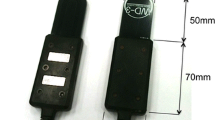Abstract
Real-time information on salinity levels and transport of fertilizers are generally missing from soil profile knowledge bases. A dual-frequency multisensor capacitance probe (MCP) is now commercially available, for sandy soils, to simultaneously monitor volumetric soil water content (VWC) measured as a percentage and salinity as a unitless volumetric ion content (VIC). The objectives of this research were to assess the relationship of salinity and water content with these dual-frequency MCPs under laboratory conditions, and assess its potential for field use in sandy soils of the mid-Atlantic region of the US. Water and salinity studies were conducted in two sand-filled PVC columns, 1.2 m long by 0.25 m ID. Each column was instrumented with ten dual-frequency capacitance sensors and two thermocouple temperature sensors. Four salinity levels were studied in the two columns using 0.5, 1, 2, and 4 dSm−1 NH4NO3 solutions. Water, salinity, and temperature readings were continuously recorded at 1-min intervals. The VIC values were found to be primarily qualitative, but combined with real-time VWC measures the probe could still be an important fertigation management tool to provide near-continuous real-time information on fertilizer penetration, spread and subsequent changes during crop growth.








Similar content being viewed by others
Notes
Trade names are used in this publication to provide specific information. Mention of a trade name does not constitute a guarantee or warranty of the product or equipment by the USDA or an endorsement over other similar products.
The raw f L response values and the formula for calculating VIC are not made available to the user.
“Content” not concentration. VIC is unitless as provided by the manufacturer.
References
Anonymous (1999) Soil taxonomy. USDA-NRCS Agric. Handbook 436
Buss P (1993) The use of capacitance based measurements of real time soil water profile dynamics for irrigation scheduling. In: Proceedings of the National Conference of the Irrigation Association, Australia and the National Committee on Irrigation and Drainage, Launceston, Tasmania, 17–19 May 1993
Buss P, Dalton M, Green S, Guy R, Roberts C, Gatto R, Levy G (2004) Use of TriSCAN® for measurement of water and salinity in the soil profile. 1st National Salinity Engineering Conference 9–12 November 2004. Perth, Western Australia
Campbell JE (1990) Dielectric properties and influence of conductivity in soils at one to fifty megahertz. Soil Sci Soc Am J 54:332–341
Campbell JE (2007) Interplay of soil moisture, conductivity, and temperature in soil moisture sensors––a theoretical overview and practical implications. In: Paltineanu IC (ed) Transaction of second international symposium on soil water measurement using capacitance, impedance and time domain transmission. October 28–November 2, 2007. Beltsville, MD, 1.2-1–1.2-11
Dalton M, Buss P, Gatto R, Levy G, Olden S, Guy R (2004) TriSCAN®: a continuous method of fertilizer/salinity and soil water profiling: the theory and application in a vineyard irrigated with saline water, Proceedings irrigation association of Australia: coming of age! conference, Adelaide Convention Centre, 11–13 May 2004
Das BS, Wraith JM, Inskeep WP (1999) Nitrate concentrations in the root zone estimated using time domain reflectometry. Soil Sci Soc Am J 63:1561–1570
Fares A, Alva AK (2000) Evaluation of capacitance probes for optimal irrigation of citrus through soil moisture monitoring in an entisol profile. Irrig Sci 19(2):57–64
Kelleners TJ, Soppe RWO, Robinson DA, Schaap MG, Ayars JE, Skaggs TH (2004a) Calibration of capacitance probe sensors using electric circuit theory. Soil Sci Soc Am J 68:430–439
Kelleners TJ, Soppe RWO, Ayars JE, Skaggs TH (2004b) Calibration of capacitance probe sensors in a saline silty clay soil. Soil Sci Soc Am J 68:770–778
Mallants D, Vanclooster M, Toride N, Vanderborght J, van Genuchten M, Th Feyen J (1996) Comparison of three methods to calibrate TDK for monitoring solute movement in undisturbed soil. Soil Sci Soc Am J 60:747–754
McCann IR, Starr JL (2007) Use of multisensor capacitance probes as irrigation management tool in humid areas: case studies and experiments from the mid-atlantic region. Applied Eng Agric 23(4):475–483
Noborio K (2001) Measurement of soil water content and electrical conductivity by time domain reflectometry: a review. Comput Electron Agric 31:213–237
Paltineanu IC, Starr JL (1997) Real-time soil water dynamics using multisensor capacitance probes: laboratory calibration. Soil Sci Soc Am J 61:1576–1585
Polyakov V, Fares A, Ryder MH (2005) Calibration of a capacitance system for measuring water content of tropical soil. Vadose Zone J 4:1004–1010
Starr JL, Paltineanu IC (2002) Capacitance devices. In: J.H. Dane, G.C. Topp (eds) Methods of soil analysis. Part 4. Physical methods. SSSA Book Ser. 5. SSSA, Madison, WI, p 463–474
Starr JL, Timlin DJ (2004) Using high-resolution soil moisture data to assess soil water dynamics in the vadose zone. Vadose Zone J 3:926–935
Walker G, Gilfedder M, Williams J (1999) Effectiveness of current farming systems in the control of dryland salinity, CSIRO publication. CSIRO land and water, Black Mountain Laboratories, Clunies Ross Street, Canberra, ACT Australia 2601; http://www.clw.csiro.au
Watson K, Gatto R, Weir P, Buss P (1995) Moisture and salinity sensor and method of use, United States Patent, US005418466A
Acknowledgments
The authors are grateful to Mr. Randy Rowland, support scientist at the USDA-ARS, for valuable assistance and technical support. They also thank Dr. Jeff Campbell, Campbell Consulting, Horseshoe Bend, ID, for helpful discussions and critical review of the draft manuscript.
Author information
Authors and Affiliations
Corresponding author
Additional information
Communicated by P. Waller.
Rights and permissions
About this article
Cite this article
Starr, J.L., Timlin, D.J., Downey, P.M. et al. Laboratory evaluation of dual-frequency multisensor capacitance probes to monitor soil water and salinity. Irrig Sci 27, 393–400 (2009). https://doi.org/10.1007/s00271-009-0154-3
Received:
Accepted:
Published:
Issue Date:
DOI: https://doi.org/10.1007/s00271-009-0154-3




